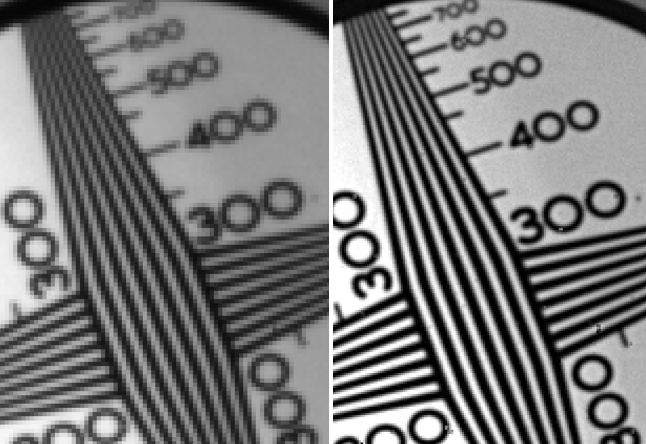Super-Resolution
Super-Resolution is a technique to generate a higher resolution image from multiple lower resolution images. Photonic Science is offering a Super-Resolution SWIR camera that will extend its native VGA-resolution 640 x 512 pixel image format up to SXGA with 1280 x 1024 pixel resolution.
In the camera, dual piezo linear translation stages shift the focal plane by ½ pixel in both x and y directions between four consecutive captured images. The four individual images are corrected for non-uniformities in the PC software before being combined into a single higher resolution final image. An image reconstruction algorithm then performs digital sharpening on the final image to enhance edge modulation and to provide improved MTF at the higher spatial frequencies..
By acquiring images shifted by ½ pixel as described above, the camera allows spatial frequencies above the sensor’s Nyquist limit to be imaged without the aliasing artefacts that occur in standard mode. The image below shows the effect clearly. On the left is a detail from a USAF chart image acquired in standard 640 X 512 mode. The set of resolution bars in the vertical column on the left have spatial frequencies higher than the sensor’s Nyquist limit, ie the width of a black and white pair of lines is less than two pixels on the sensor. At these high spatial frequencies aliasing occurs, seen as irregular width bars, and bars that seem to disappear completely and become blocks of mid-grey. When the same chart is imaged in Super Resolution mode, however, the image on the right is obtained: aliasing artefacts are removed, and clear modulation of the high spatial frequency bars is produced.
The camera driver supplied by Photonic Science includes additional image reconstruction techniques that can then be used to increase the modulation of the Super Resolution image. The subjective effect of these is to sharpen the final image and increase contrast.
The acquisition is performed seamlessly by Photonic Science Viewer software or SDK, presenting a 1280 x 1024 image to the end user.
The SWIR camera is cooled and maintains its extended exposure capabilities for low light level imaging applications such as small animal imaging, semiconductor or solar cell inspection.
Photonic Science SWIR cameras also provide four point in-camera corrections, correcting for offset, darkcurrent, flatfield, and defective pixel non-uniformities. This offers superior image quality without software intervention. If yours is an application with very low photon flux then we can offer a water-cooled solution that allows very long exposures to be acquired (over 1 minute), with well controlled darkcurrent corrections.
If you have specific requirements and would like to talk to a sales representative about a potential solution, we can help. Contact a member of the Photonics Science team today to learn more about our custom SWIR camera solutions.
We Recommend...
Cooled VGA SWIR InGaAs Camera

Contact Us
22 Theaklen Drive,
Saint Leonards-on-sea,
TN38 9AZ,
United Kingdom

